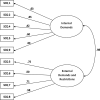Stress of Conscience Questionnaire (SCQ): exploring dimensionality and psychometric properties at a tertiary hospital in Australia
- PMID: 33081845
- PMCID: PMC7576718
- DOI: 10.1186/s40359-020-00477-3
Stress of Conscience Questionnaire (SCQ): exploring dimensionality and psychometric properties at a tertiary hospital in Australia
Abstract
Background: This study explored the psychometric properties and dimensionality of the Stress of Conscience Questionnaire (SCQ) in a sample of health professionals from a tertiary-level Australian hospital. The SCQ, a measure of stress of conscience, is a recently developed nine-item instrument for assessing frequently encountered stressful situations in health care, and the degree to which they trouble the conscience of health professionals. This is relevant because stress of conscience has been associated with negative experiences such as job strain and/or burnout. The validity of SCQ has not been explored beyond Scandinavian contexts.
Methods: A cross-sectional study of 253 health professionals was undertaken in 2015. The analysis involved estimates of reliability, variability and dimensionality. Exploratory factor analysis (EFA) and confirmatory factor analysis (CFA) were used to explore dimensionality and theoretical model fit respectively.
Results: Cronbach's alpha of 0.84 showed internal consistency reliability. All individual items of the SCQ (N = 9) met the cut-off criteria for item-total correlations (> 0.3) indicating acceptable homogeneity. Adequate variability was confirmed for most of the items, with some items indicating floor or ceiling effects. EFA retained a single latent factor with adequate factor loadings for a unidimensional structure. When the two-factor model was compared to the one-factor model, the latter achieved better goodness of fit supporting a one-factor model for the SCQ.
Conclusion: The SCQ, as a unidimensional measure of stress of conscience, achieved adequate reliability and variability in this study. Due to unidimensionality of the tool, summation of a total score can be a meaningful way forward to summarise and communicate results from future studies, enabling international comparisons. However, further exploration of the questionnaire in other cultures and clinical settings is recommended to explore the stability of the latent one-factor structure.
Keywords: Dimensionality; Exploratory factor analysis and confirmatory factor analysis; Health professionals; Psychometrics; Stress of conscience.
Conflict of interest statement
The authors declare no potential competing interest with respect to the research, authorship, and publication of this article.
Figures


Similar articles
-
Development and initial validation of the Stress of Conscience Questionnaire.Nurs Ethics. 2006 Nov;13(6):633-48. doi: 10.1177/0969733006069698. Nurs Ethics. 2006. PMID: 17193804
-
The Chinese version of the Perceived Stress Questionnaire: development and validation amongst medical students and workers.Health Qual Life Outcomes. 2020 Mar 13;18(1):70. doi: 10.1186/s12955-020-01307-1. Health Qual Life Outcomes. 2020. PMID: 32169070 Free PMC article.
-
Psychometric properties concerning four instruments measuring job satisfaction, strain, and stress of conscience in a residential care context.Arch Gerontol Geriatr. 2013 Sep-Oct;57(2):162-71. doi: 10.1016/j.archger.2013.04.001. Epub 2013 May 2. Arch Gerontol Geriatr. 2013. PMID: 23643346
-
Development and validation of the COVID-19 Impact Scale in Australia.Curr Med Res Opin. 2023 Oct;39(10):1341-1354. doi: 10.1080/03007995.2023.2247323. Epub 2023 Sep 7. Curr Med Res Opin. 2023. PMID: 37656161 Review.
-
Development of the perceived miscommunication measure in the pediatric intensive care unit.J Pediatr Nurs. 2023 Jul-Aug;71:e135-e141. doi: 10.1016/j.pedn.2023.05.011. Epub 2023 Jun 1. J Pediatr Nurs. 2023. PMID: 37270386 Review.
Cited by
-
Concept analysis of conscience-based nursing care: a hybrid approach of Schwartz-Barcott and Kim's hybrid model.BMC Med Ethics. 2024 Jun 18;25(1):70. doi: 10.1186/s12910-024-01070-8. BMC Med Ethics. 2024. PMID: 38890687 Free PMC article.
-
The influence of nursing home managers' leadership on person-centred care and stress of conscience: A cross-sectional study.BMC Nurs. 2021 Oct 15;20(1):200. doi: 10.1186/s12912-021-00718-9. BMC Nurs. 2021. PMID: 34654423 Free PMC article.
-
Moral Distress among Frontline Physicians and Nurses in the Early Phase of COVID-19 Pandemic in Italy.Int J Environ Res Public Health. 2022 Aug 5;19(15):9682. doi: 10.3390/ijerph19159682. Int J Environ Res Public Health. 2022. PMID: 35955032 Free PMC article.
-
Stress of conscience of COVID-19 among perianaesthesia nurses having worked in a COVID-ICU during the coronavirus pandemic: an international perspective.BMC Nurs. 2022 Apr 7;21(1):82. doi: 10.1186/s12912-022-00862-w. BMC Nurs. 2022. PMID: 35392899 Free PMC article.
-
Moral distress among inpatient child and adolescent psychiatry staff: a mixed-methods study of experiences and associated factors.Child Adolesc Psychiatry Ment Health. 2025 Feb 28;19(1):16. doi: 10.1186/s13034-025-00868-7. Child Adolesc Psychiatry Ment Health. 2025. PMID: 40022125 Free PMC article.
References
-
- Alkrisat M, Alatrash M. Stress of conscience: concept clarification. Online J Health Ethics. 2016;12:1. doi: 10.18785/ojhe.1201.02. - DOI
MeSH terms
LinkOut - more resources
Full Text Sources
Medical
Miscellaneous

